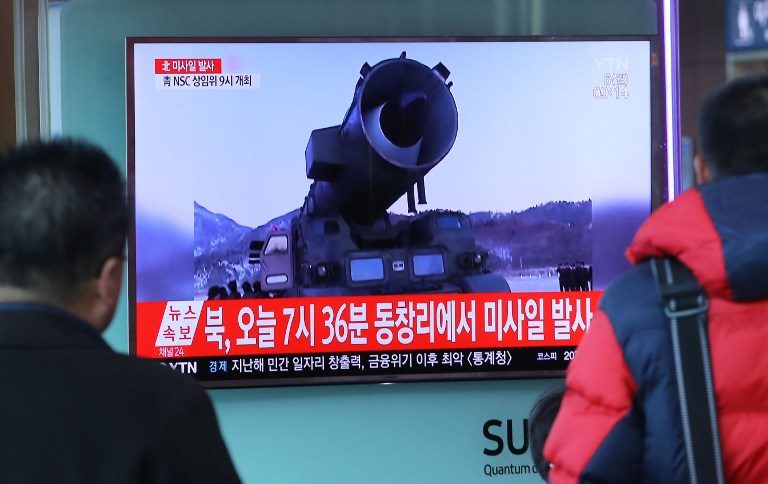SUMMARY
This is AI generated summarization, which may have errors. For context, always refer to the full article.

SEOUL, South Korea (UPDATED) – Nuclear-armed North Korea said Tuesday, March 7, its missile launches were training for a strike on US bases in Japan, as global condemnation of the regime swelled.
Three of the four missiles fired Monday came down provocatively close to US ally Japan, in waters that are part of its exclusive economic zone, representing a challenge to US President Donald Trump.
In separate phone calls, Trump – whose rhetoric on the campaign trail had raised doubts about the issue – reaffirmed Washington’s “ironclad commitment” to Japan and South Korea.
The US will demonstrate to Pyongyang that there were “very dire consequences” for its actions, the White House said in a statement.
The United Nations Security Council scheduled an emergency meeting for Wednesday after a request by Washington and Tokyo to discuss additional measures following the launch.
Under UN resolutions, Pyongyang is barred from any use of ballistic missile technology, and the US ambassador to the UN, Nikki Haley, said on Twitter that the world “won’t allow” North Korea to continue on its “destructive path”.
But six sets of UN sanctions since its first nuclear test in 2006 have failed to halt its drive for what it insists are defensive weapons.
‘Feasting his eyes’
Kim Jong-Un gave the order for the drill to start, the North’s official Korea Central News Agency (KCNA) reported.
“Feasting his eyes on the trails of ballistic rockets”, he praised the Hwasong artillery unit that carried it out, it said.
“The four ballistic rockets launched simultaneously are so accurate that they look like acrobatic flying corps in formation, he said,” the agency added, referring to Kim.
The military units involved are “tasked to strike the bases of the US imperialist aggressor forces in Japan in contingency”, KCNA said.
The Korean version of the KCNA report said the North’s missile launch demonstrated its readiness to “wipe out” enemy forces with a “merciless nuclear strike”.
A series of photographs published by the North’s Rodong Sinmun newspaper showed Kim watching the missiles rise into the air and another of him smiling gleefully, clapping with other officials.
Seoul and Washington last week began annual joint military exercises that always infuriate Pyongyang.
It regularly issues threats against its enemies, and carried out two atomic tests and a series of missile launches last year, but Monday was only the second time its devices have come down in Japan’s EEZ.
The launches came ahead of a trip by new US Secretary of State Rex Tillerson to the region.
Choi Kang, an analyst at the Seoul-based Asan Institute for Policy Studies, said the launch was a warning to Tokyo.
“North Korea is demonstrating that its target is not just limited to the Korean peninsula anymore but can extend to Japan at anytime and even the US,” he said.
Trump has described North Korea as a “big, big problem” and vowed to deal with the issue “very strongly”.
White House spokesman Sean Spicer said Monday the administration was taking steps to “enhance our ability to defend against North Korea’s ballistic missiles”.
The New York Times reported at the weekend that under former president Barack Obama the US stepped up cyber attacks against North Korea to try to sabotage its missiles before launch or just as they lift off.
Beijing frustrated
The US military has begun deploying the THAAD anti-ballistic missile defense system to South Korea to protect against threats from the North, US Pacific Command said, with its first elements arriving on Monday.
Pyongyang wants to develop an intercontinental ballistic missile (ICBM) capable of reaching the US mainland — something Trump has vowed would not happen.
It has undoubtedly made progress in its efforts in recent years, although questions remain over its ability to master re-entry technology and miniaturise a nuclear weapon sufficiently to fit it onto a missile warhead.
The THAAD deployment has infuriated China, the North’s key diplomatic ally and crucial to efforts to persuade it to change its ways, and it has imposed several steps seen as economic retaliation against South Korea.
Foreign ministry spokesman Geng Shuang said Tuesday that Beijing remained “firmly opposed” to THAAD and will “resolutely take necessary measures to defend our own security interests”.
Beijing has become increasingly frustrated with Pyongyang’s nuclear and missile activities, and last month announced a suspension of all coal imports from the North until the end of the year — a crucial source of foreign currency.
The North’s missile launch could have been an attempt to distract attention from the murder of Kim Jong-Nam at Kuala Lumpur International Airport last month, South Korea’s acting president Hwang Kyo-Ahn said Tuesday.
Seoul has blamed Pyongyang for the killing of the half-brother of the North’s leader by two women using VX nerve agent.
With diplomatic tensions soaring, Pyongyang announced Tuesday it was banning Malaysians in North Korea from leaving the country, prompting a similar response from Kuala Lumpur. Both had already expelled the other’s ambassador. – Rappler.com
Add a comment
How does this make you feel?
There are no comments yet. Add your comment to start the conversation.